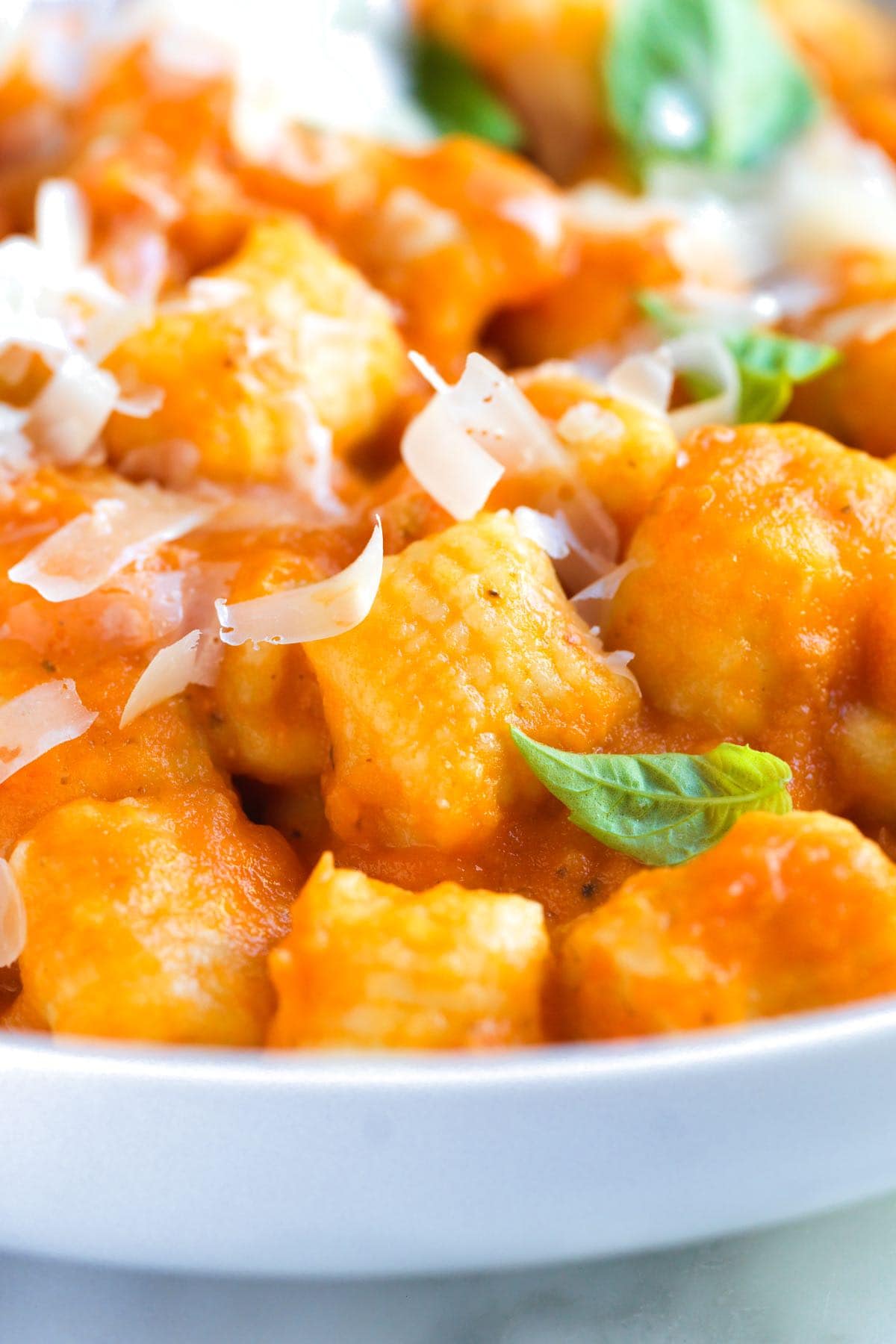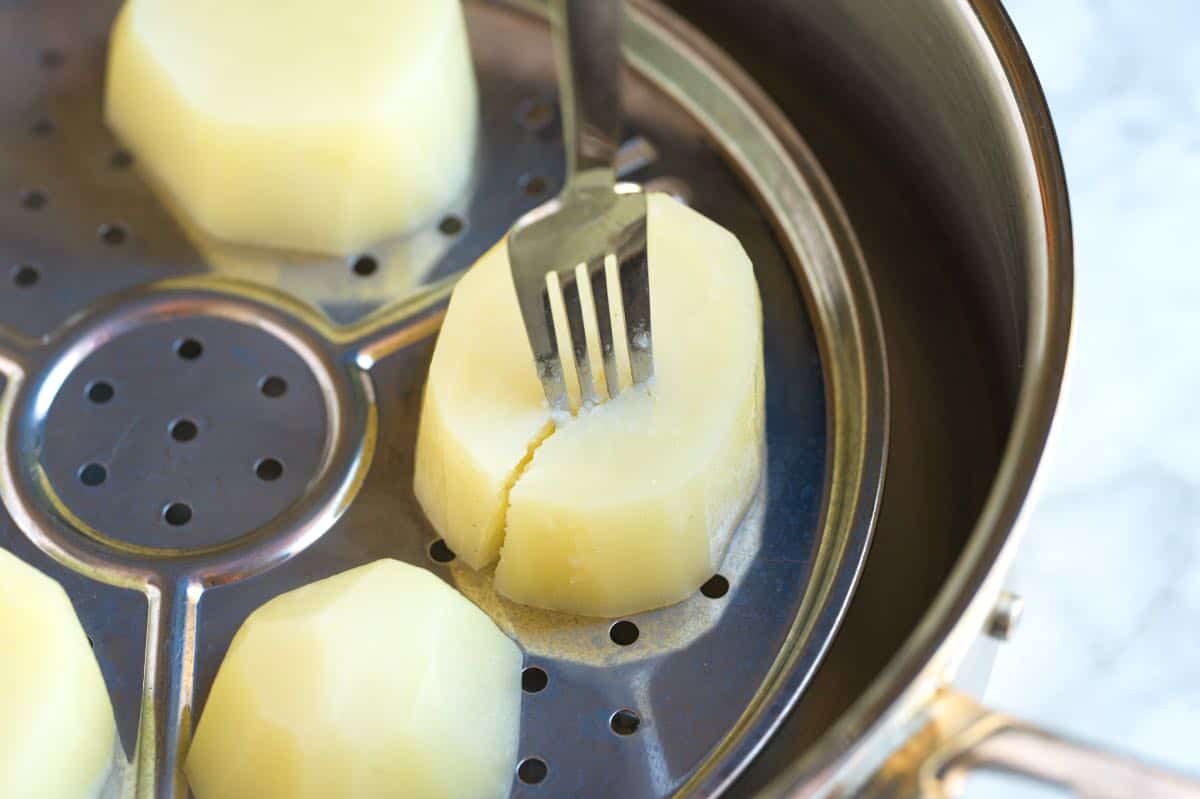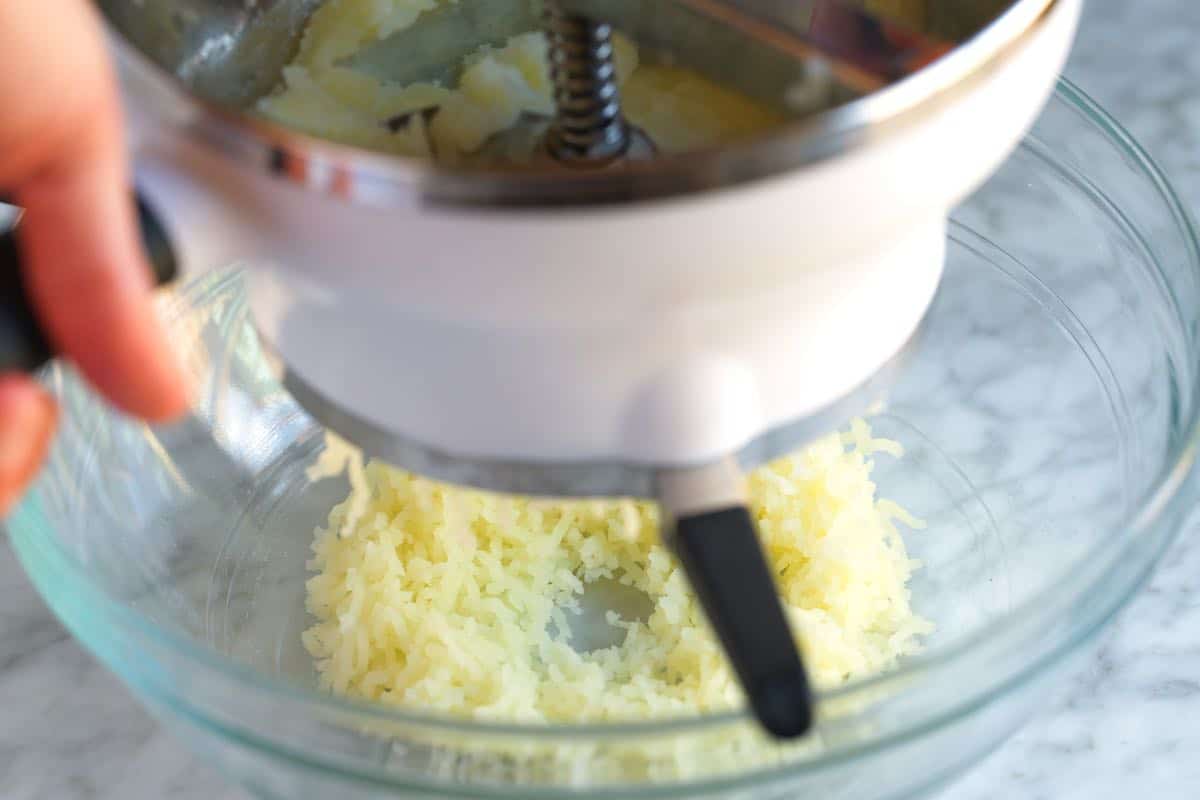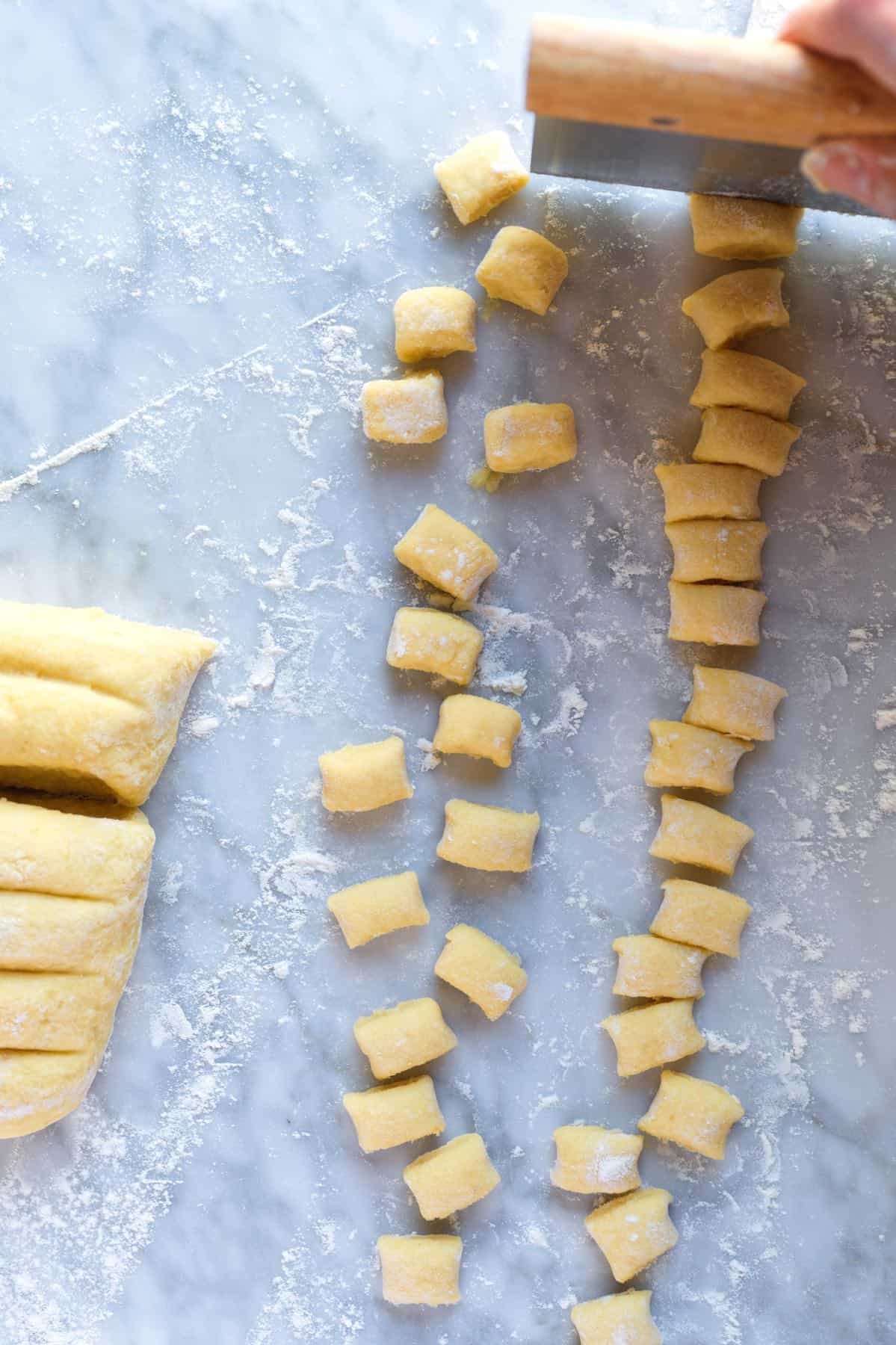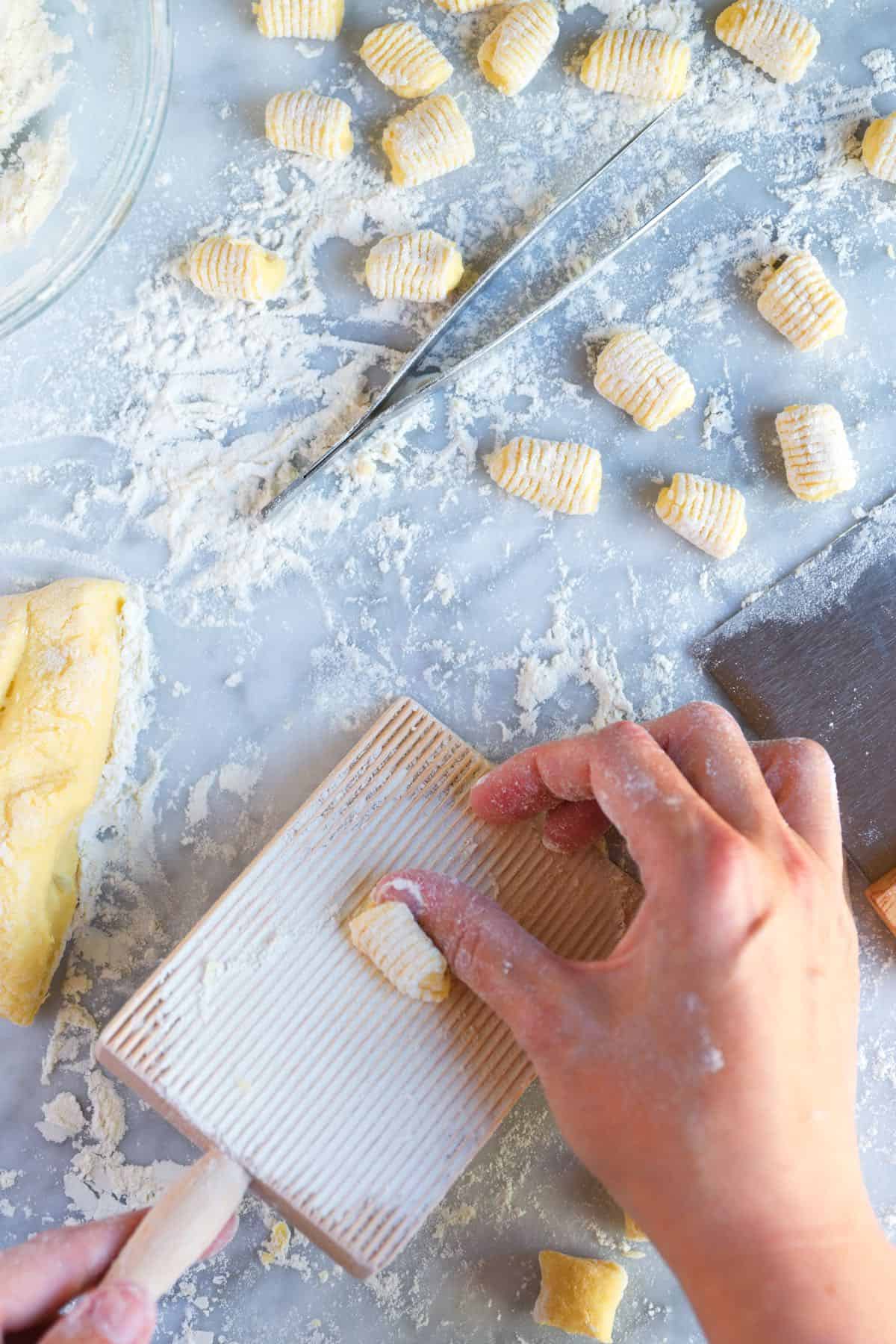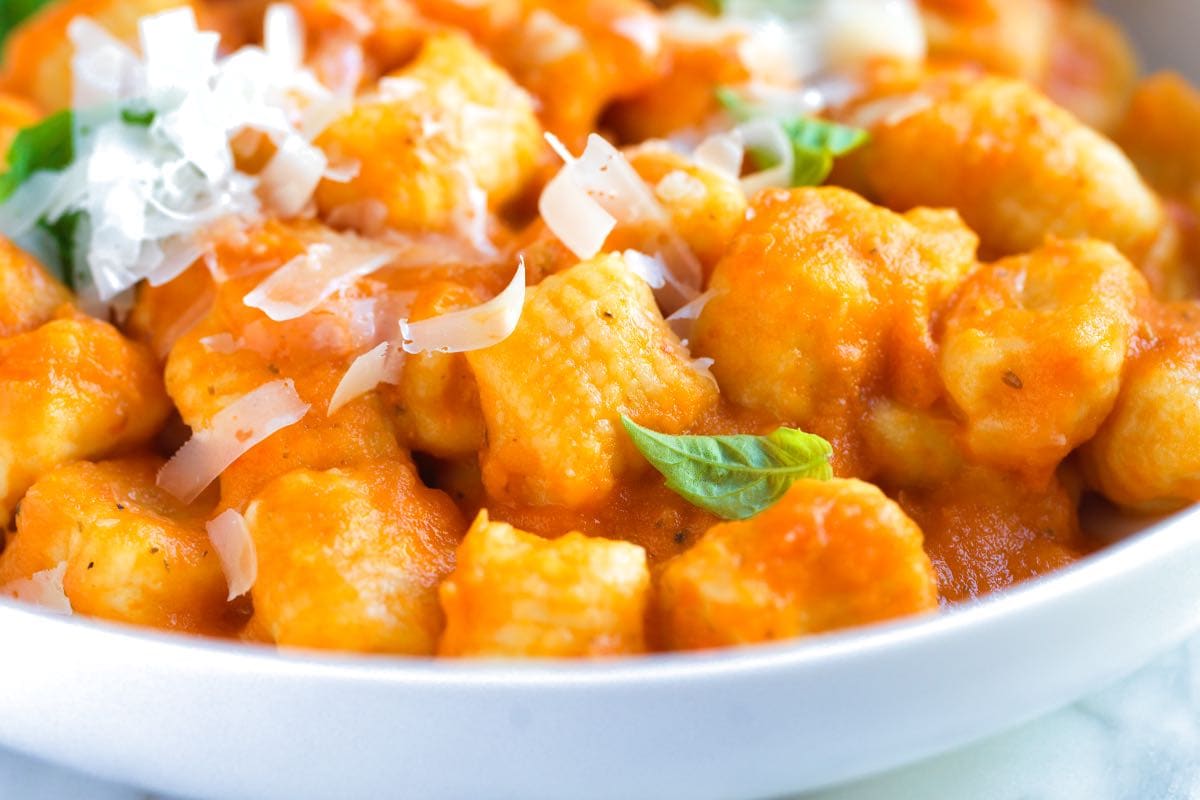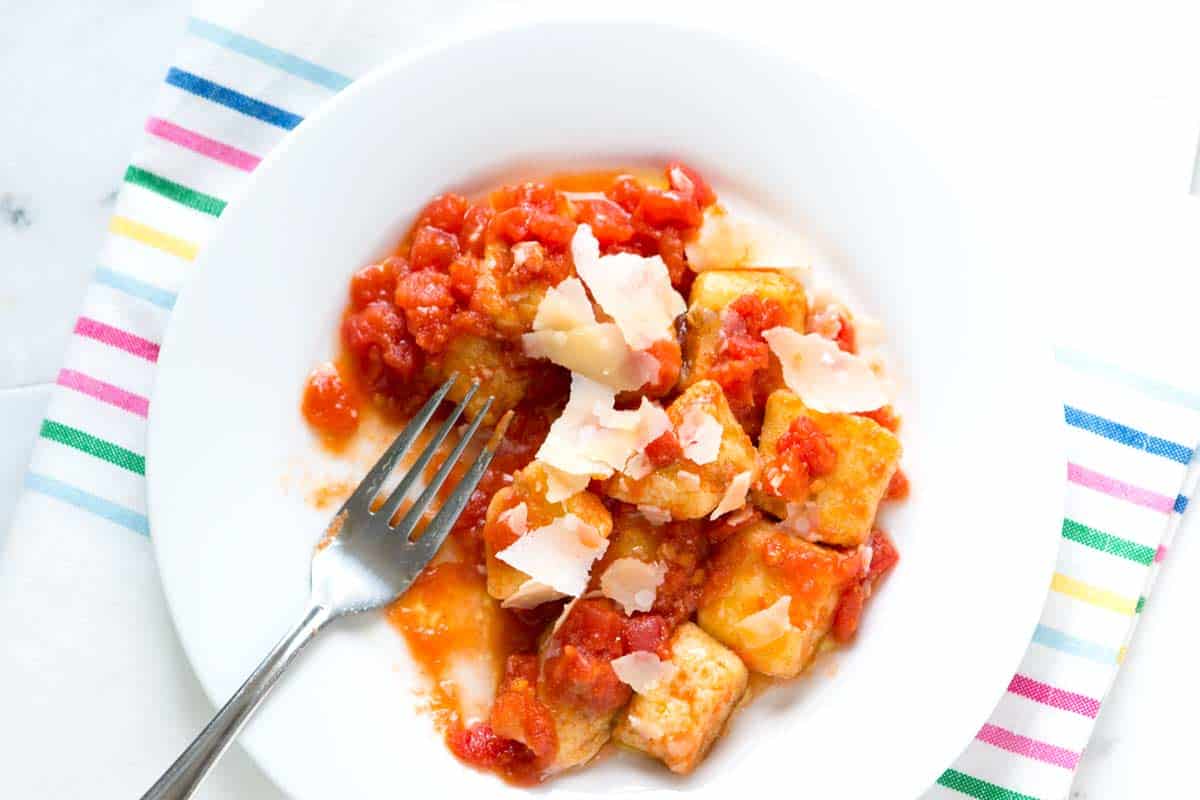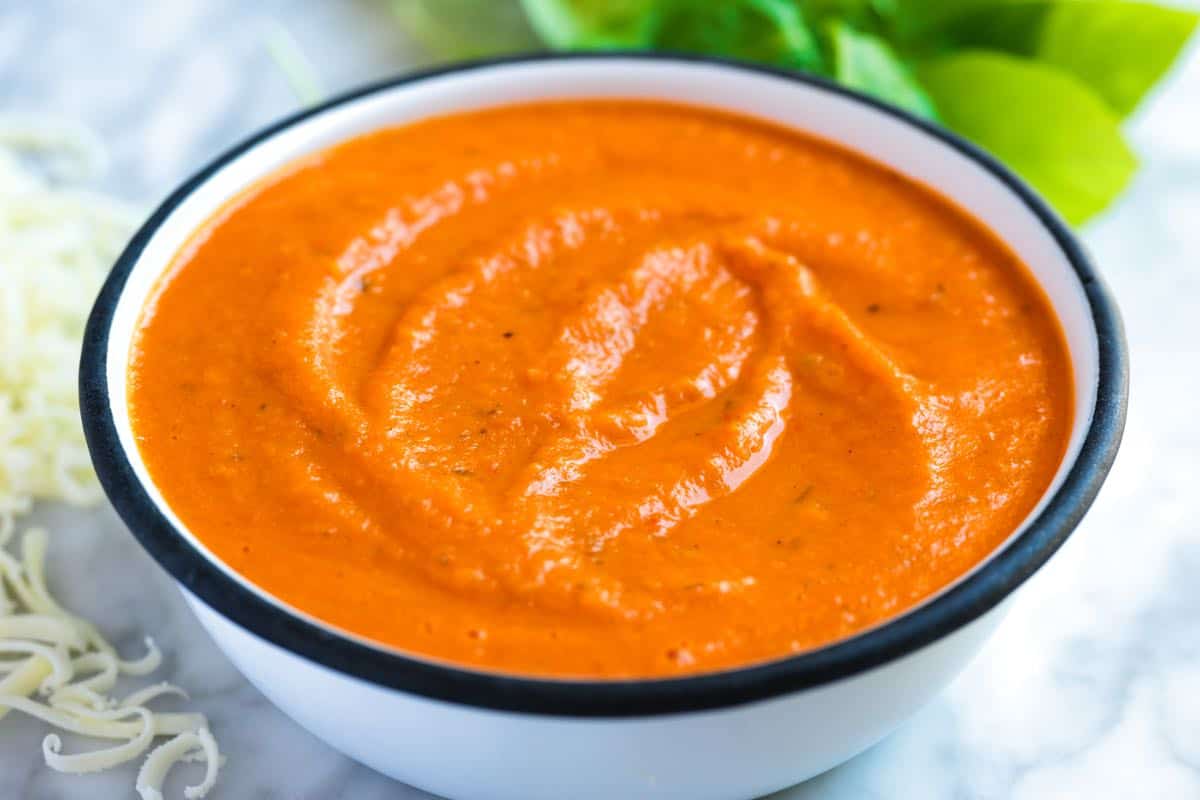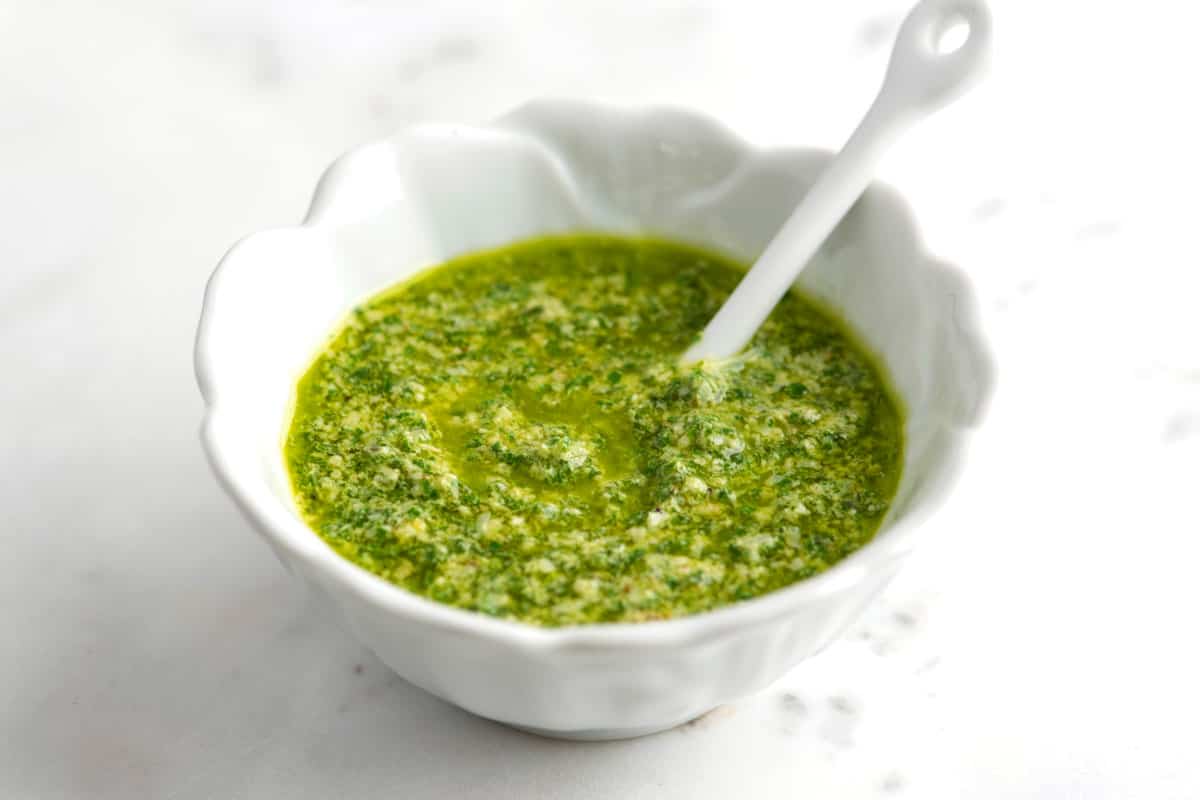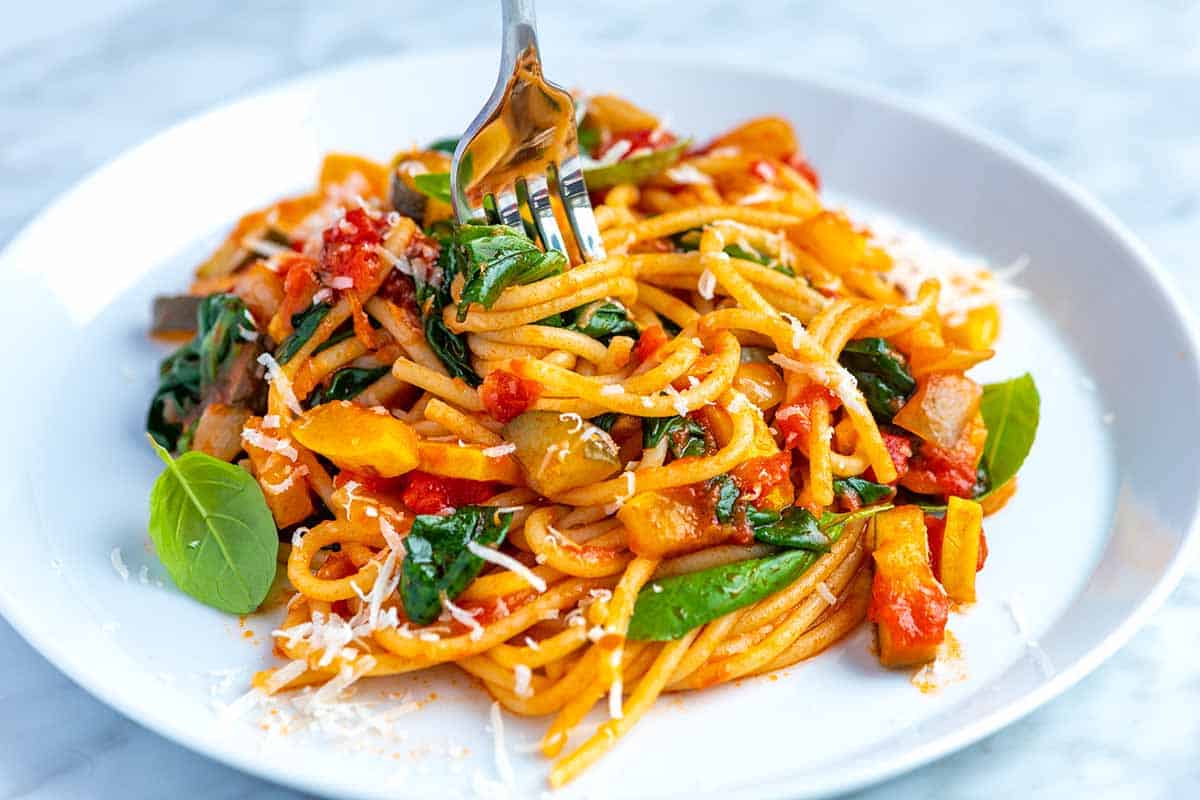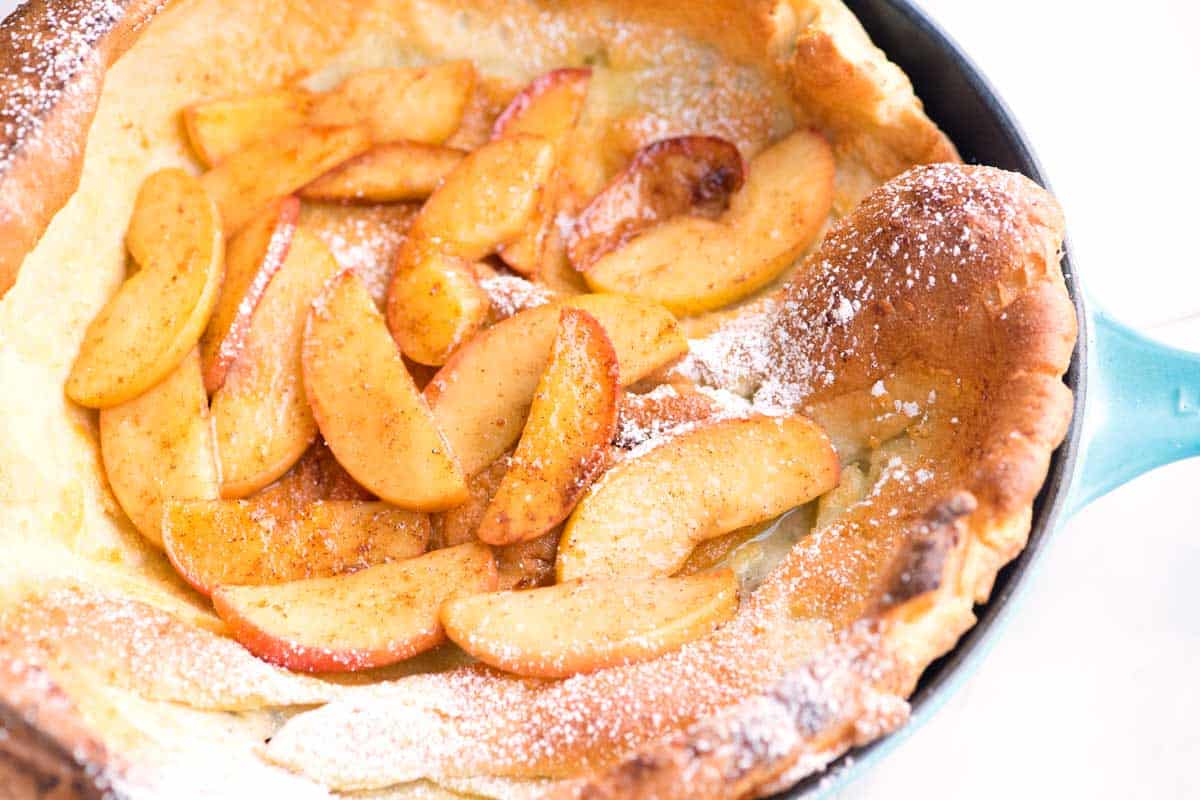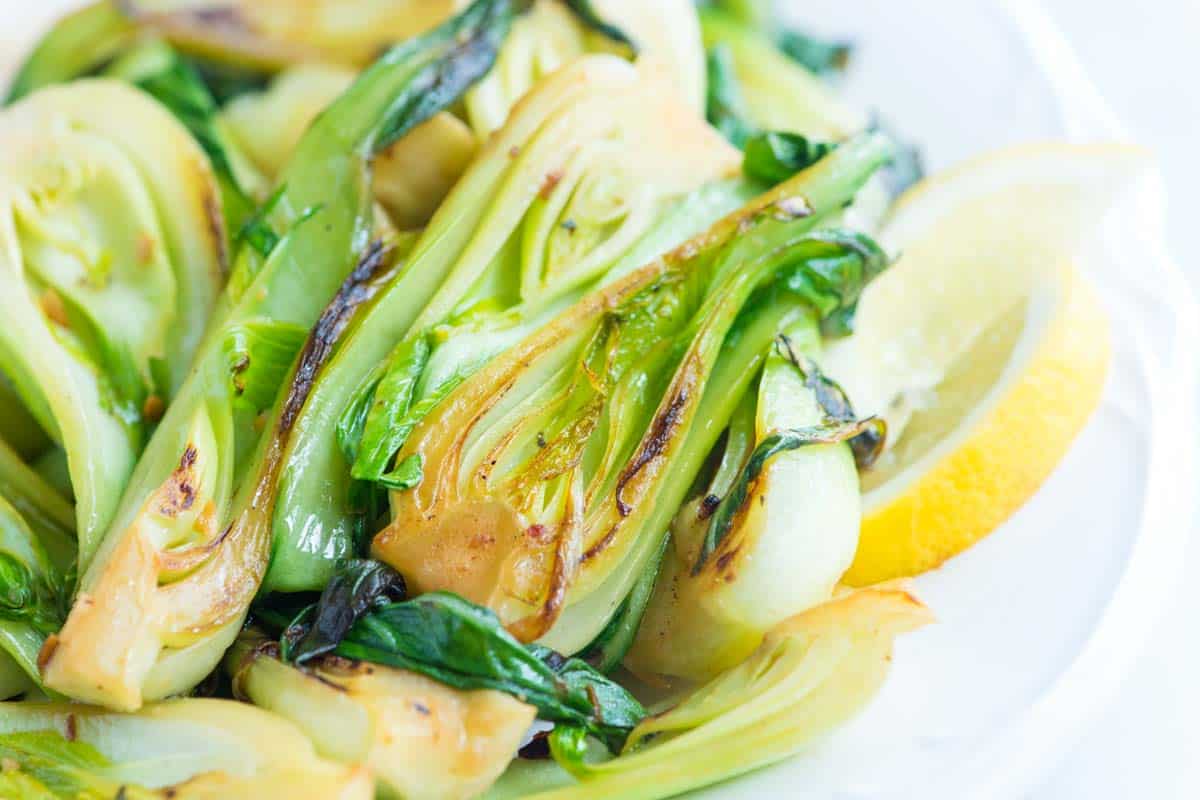Gnocchi (pronounced “nyoh-kee”) are light and fluffy Italian dumplings made with cooked potatoes, flour, and egg. Store-bought gnocchi has nothing on our homemade version (trust me). For another recipe, see our easy ricotta gnocchi, which swaps the potato in this recipe for creamy ricotta cheese.
Key Ingredients
Potatoes: I always use Russet potatoes for the best gnocchi (and most Italian grandmothers would agree!). Their high starch and low moisture content are key. The starch helps the dough stick together, creating that signature light and fluffy gnocchi texture. Flour: You can use either all-purpose or “00” flour for this recipe. Many traditional Italian recipes call for “00” flour, but don’t stress if you don’t have it. All-purpose works perfectly well. Olive Oil: While not every gnocchi recipe includes olive oil, a bit adds flavor and helps the dough come together smoothly. Salt: Super important for flavor! I prefer fine sea salt because it dissolves easily into the dough. Egg: You can technically make gnocchi without eggs, but they make the dough much easier to work with. Our recipe uses a whole egg and an additional yolk. They bind the dough, add a touch of richness, and make the gnocchi tender.
How to Make Gnocchi
I’m so excited for you to try this gnocchi recipe! Yes, gnocchi takes a little time, but it’s worth it. Plus, you’ll get better and faster each time you make it. Let’s start with those potatoes! I’ve tried baking, boiling, and steaming for this recipe, and steaming is the clear winner. Steamed potatoes absorb less water than when boiling, and steaming is much faster than baking. Peel them, pop them into a steamer basket over simmering water, cover, and cook until they’re easily pierced with a fork. For the smoothest texture, I use my food mill to process the cooked potatoes (a potato ricer works just as well). If you don’t have either, a fork is fine for mashing. Just be careful not to overwork them, or they’ll get gummy. You want a mostly smooth texture, with a few small lumps being totally okay (this might seem a bit fussy, but it makes a big difference in the final gnocchi). Next, stir in the olive oil, salt, egg, and egg yolk to create the gnocchi dough. Dust over the flour and mix with a spoon until it forms a rough dough. Then, spend about 2 minutes working the dough in the bowl until it’s smooth and soft. Now it’s time to form our delicious little dumplings! The easiest way is to roll the dough into long ropes, cut them into 3/4-inch pieces, and drop them straight into simmering water. This is my go-to for a quick and tasty meal. Use a gnocchi board if you want a fancier, more traditional look! I show you how in our video. This gives the gnocchi those cute ridges and a dimple for the sauce to cling to. Though it takes a little practice, it’s definitely fun to learn. (If I plan on searing the gnocchi later, I usually skip the board since the ridges disappear a bit.) Now for the cooking! Drop your gnocchi into simmering water, wait for them to float, and give them a couple more minutes before scooping them out with a slotted spoon. Then, you have 2 options! Toss the gnocchi directly into warm sauce, or sear them in a hot skillet with butter or oil until golden brown and a little crispy.
Ways to Serve Gnocchi
Our family loves gnocchi, so we’ve come up with quite a few ways to enjoy it. Toss your gnocchi with your favorite tomato sauce. It can be a simple marinara or something more robust like arrabbiata. My family loves this homemade gnocchi tossed in this pizza sauce (I know it’s odd, but it’s so good!). Seared in butter, herbs (like sage), and parmesan is always a hit, and I love tossing it with pesto. Try homemade basil pesto in the summer and kale pesto in the winter. You can even turn it into a casserole (think macaroni and cheese but made with gnocchi instead of pasta). Sheet pan meals work, too. Toss on your favorite veggies, some sliced sausage, and the poached (simmered) gnocchi. Add a drizzle of olive oil, and you will be ready to bake. *Note that russet potatoes vary significantly in size, so we highly recommend weighing your potatoes for this recipe. 1 ¾ cup + 2 tablespoons (250g) all-purpose flour or Italian “00” flour 1 teaspoon (6g) fine sea salt 1 tablespoon olive oil 1 large egg 1 large egg yolk 2Peel the potatoes and cut into 1-inch-thick slices. When the water is simmering, place the potatoes into the steamer basket. Cover with a lid and steam until the potatoes can easily be pierced with a fork, 15 to 20 minutes. 3Push the steamed potatoes through a food mill (medium blade) or potato ricer set over a large mixing bowl. See introduction above if you do not have a food mill or potato ricer. 4Use a wooden spoon to stir in the salt, olive oil, egg, and egg yolk until combined. Scatter the flour on top and gently mix with the spoon until a rough dough forms. 5Put down the spoon, and then use your hands to bring the dough together in the bowl, pushing the flour into the dough until it is smooth. This takes 2 to 3 minutes. 6Move onto forming the dumplings or cover tightly and refrigerate for up to 4 hours. When you are ready to form the dumplings, allow it to warm up on the counter for a bit. 2Transfer the gnocchi dough to a floured work surface. Knead a few times, and then pat into a rough rectangle. Divide the dough into eight pieces. Keep one piece of dough in the center of your work surface. Move the rest to the side and cover with a dishcloth so it does not dry out. 3Roll the dough into a long snake, about 1/2 inch in diameter. If it is too sticky, lightly dust it with more flour. Cut the snake into 3/4 inch sections (see photos in the article for reference). Repeat with the remaining dough. 4Move on to cooking the gnocchi, or use a gnocchi board to add small grooves to each dumpling. 2Lightly flour the board and hold it angled down towards the work surface. Place a dumpling at the top of the board, then using your thumb, push the dough down into the grooves while rolling forward all the way off the board at the bottom. After a few tries, you will find the right amount of pressure to use. It takes a little practice, but you will get it. When you’ve rolled all your gnocchi, you can move on to cooking them. 2If you are serving with a sauce, heat the sauce in a skillet and keep warm. If you plan on sautéing the gnocchi or saving them for later, line a baking sheet with foil or parchment paper. 3If needed, bring the water back to a simmer, and then drop the gnocchi into the water and cook them until they float. When they float, cook for 1 to 2 minutes longer. You can test for doneness — they should feel firm and not mushy. 4Transfer poached gnocchi with a slotted spoon to your sauce or the prepared baking sheet to cool. Repeat with the remaining gnocchi. 5If you are sautéing the gnocchi, allow them to rest on the baking sheet for a few minutes, then heat butter or oil in a skillet and sauté. Tossing in some shredded cheese and fresh herbs is a lovely idea.

